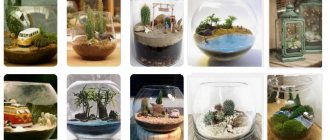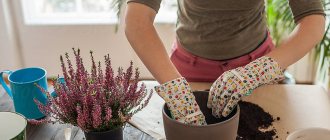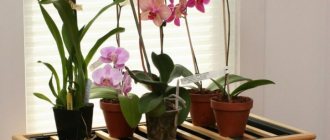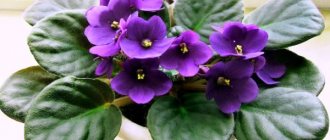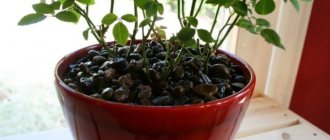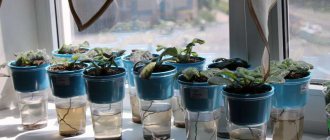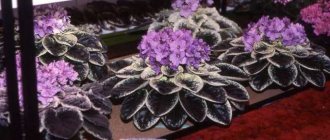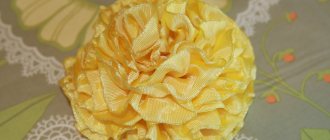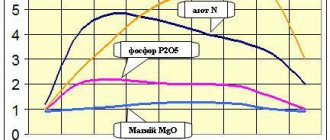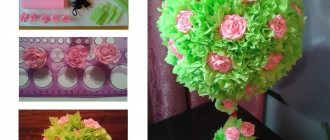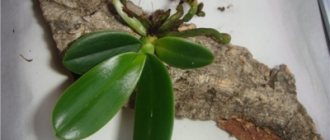Plants » Flowers
0
253
Article rating
Kira Stoletova
The dollar tree is an exotic flower, loved by many gardeners for its high decorative value and ease of care. Growing it at home is easy. However, in order to achieve good development of Zamioculcas, you need to know its requirements, including choosing the right land for it.
Soil for Zamioculcas
Land for Zamioculcas - what kind is needed
The main requirement that this flower places on the soil is good breathability. The most suitable combination is turf soil and sand with the addition of small pebbles or expanded clay.
This mixture will provide the rhizome with the maximum amount of oxygen for normal growth and development. Thus, it is not recommended to use loamy soils with a high level of humus for planting dollar trees. Such a mixture can lead to root rotting due to its ability to retain water for a long time.
If you use self-prepared soil rather than purchased soil, it is recommended to thoroughly disinfect the mixture before direct planting. This can be done by pouring boiling water over the substrate, or by placing it in the oven for a while.
Is soil suitable for zamioculcas for cacti, what kind of soil is better to buy?
If you don’t have the opportunity or lack the experience to make your own substrate, don’t despair. You can purchase a ready-made mixture at any specialty store.
The most common ones include:
- Soil for cacti and succulents - provides good breathability, which is important for the normal growth and development of the flower;
- A universal substrate mixed with sand and a small amount of expanded clay or perlite. These mixtures are in no way inferior in quality to those made by hand.
In addition, store-bought mixtures can be a real salvation for a novice gardener, because they will reduce the risk of making a mistake and destroying the plant to a minimum.
Suitable composition
The main requirement for soil for zamioculcas is sufficient air permeability. The soil should be loose and fluffy. Compliance with these characteristics can be achieved by mixing the following components in equal proportions:
- turf; sand;
- peat soil with weak acidity;
- leaf soil.
This substrate can be used when planting a purchased plant in a permanent pot, and for replanting in the future.
Before transplanting, the pot must be filled with drainage to 1/5-1/4 part. For these purposes, you can use purchased mixtures, or prepare the material yourself from stones, broken bricks, shards and other objects that drain the soil well. When choosing which soil to plant a plant in, you can also consider ready-made options that are easy to purchase in specialized stores for flower growers.
How to choose ready-made soil
If, when choosing a substrate for zamioculcas, you pay attention to the finished soil, the following will be suitable for this flowerpot: universal soil for indoor plants; soil for cacti and succulents. A universal ready-made substrate has both pros and cons.
Advantages:
- no time spent on preparation;
- In the finished soil, all substances are combined in the required proportions.
Flaws:
- when purchasing ready-made soil, it is impossible to accurately select the components depending on the individual qualities of the plant;
- It is better to supplement a universal substrate for indoor plants with additives in the form of expanded clay, coal and sand, which you will have to add yourself.
When buying ready-made soil, you need to pay attention first of all to the composition. It should list all the components necessary for zamioculcas in quantitative terms or in percentages relative to the total mass. When choosing soil, you need to pay attention to the release date of the package and its expiration date. Upon visual inspection, there should be no mold films on the surface, and when feeling the package, there should be no straws.
What additives should be added to the soil for Zamioculcas?
The main property that substrate additives should have is loosening. The soil must be breathable and fully saturated with oxygen, as a result of which moisture will also be evenly distributed.
You can add the following to the soil for zamioculcas:
- vermiculite;
- expanded clay in small fractions;
- perlite;
- sphagnum;
- coarse river sand.
These materials serve their main purpose well, while also improving the quality of the soil.
An excellent solution would be to use several types of soil. You can take soil from the garden, from the garden, leaf or turf soil.
Three types of soil for Zamioculcas
What kind of soil is needed for the plant? Its composition may vary.
Mix 1
To plant zamioculcas, it is quite possible to mix two types of soil, for example, leaf and turf. If you add a little peat soil to this mixture (all ingredients are taken in equal proportions), then the composition as a whole will have very good characteristics.
Mix 2
This composition will also work. Take turf soil, mix it with sand, then add a little expanded clay and small crushed stone to the mixture.
Mix 3
Take equal parts of turf soil, leaf soil, part of the peat and add sifted sand.
Additional primer ingredients
In general, the dollar tree likes to “bask” in light and loose soil . Water and air must circulate freely through the layers of the earth. The following work well as loosening agents for any soil:
- River sand (preferably large), expanded clay pebbles (preferably small).
- Vermiculite , for example, is excellent at retaining moisture. In addition, it completely lacks an environment favorable for the growth of mold or mildew. It is excellent drainage. You can add it to the soil in any proportions.
- Perlite It is also capable of distributing moisture in the soil and protects the top soil layer from the formation of a dry crust.
- Sphagnum peat moss (translated from Greek as “natural sponge”) is unique. Sphagnum moss, even when wet, allows air to pass through it well. In addition, it has excellent antibacterial properties. This means that adding it to the soil can protect it from infection.
Thus, adding the above additives to the soil for zamioculcas perfectly heals and loosens the soil, and, accordingly, contributes to better plant growth.
Soil pre-treatment
After preparing the earthen mixture, it must be processed for disinfection purposes. The substrate for zamioculcas does not require chemicals, since sterilization can be carried out by exposure to high temperature.
There are 3 main processing methods:
- pouring boiling water over;
- sterilization in a water bath for 1.5 hours;
- Heating in the oven for 30 minutes at 70–90°C.
Primary chemical treatment
ATTENTION! It is not the soil that is treated with chemicals, but the branches of zamioculcas directly in case they are infected with spider mites, aphids or scale insects.
Spraying with a sulfate-nicotine solution will save you from aphids. It is better to disinfect leaves with a cotton swab previously soaked in the solution. One gram of the drug should be diluted in a liter of soapy water. Other pests can be dealt with by an infusion of tobacco or a soap-tobacco solution with alcohol.
How to cook it yourself?
If you are planning to plant or replant a dollar tree and there is no way to go to a specialized store for a substrate for a succulent, then preparing a soil mixture suitable for zamioculcas will not be difficult , you just need to know what kind of soil is suitable.
To plant young plants at home:
- We combine 1 part of the turf soil with the same amount of sand, expanded clay and small crushed stone.
- Mix all components thoroughly.
For transplantation:
- We combine leaf soil, turf soil, peat and sand, observing the recommended proportion of 1:1:1:1.
- Mix everything thoroughly until a homogeneous mixture is formed.
Another option: mix equal amounts of leaf and turf soil with the same volume of vermiculite and sand.
Scheme for mixing soils and additives for preparing soil:
- 1 tsp turf soil,
- 1 tsp leaf,
- 1 tsp slightly acidic peat,
- 1 teaspoon of sand without clay fractions.
Yellow leaves: what's the problem?
Who said yellow leaves are a problem?
Be aware: it is too early to conclude that the plant is sick. Zamioculcas grows slowly, and some of its leaves manage to age, turn yellow and fall off. New shoots will definitely appear in their place, and you can only worry if this does not happen. Leaves may turn yellow due to:
- Drafts;
- Sudden temperature changes;
- Low amount of moisture;
- Pests.
Determine the cause and eliminate it as soon as possible. A healthy plant will delight you with its foliage all year round if you take care of it in a timely manner!
How to determine that a succulent needs to change its substrate?
The first time you need to change the soil for a dollar tree is immediately after purchasing it from a flower shop.
Since the plant is transported from afar, suppliers plant it in a special substrate to preserve its root system. This soil is ideal for transportation, but is in no way intended for the growth and development of zamioculcas.
Further transplants of zamioculcas must be started when, after watering, the water stagnates in the pot on top of the soil. Ideally, a loose substrate, completely entwined with the roots of the plant, will quickly allow moisture to pass through, and it will safely fall into the pan.
A compacted earthen lump is a serious obstacle to the path of water : the liquid is not able to saturate the soil and remains on the surface, which threatens the plant with the formation of rotting areas, and subsequently death. Another signal that the plant needs replanting is roots sticking out of the drainage hole.
Attention! The frequency of planned Zamioculcas transplants directly depends on its age: for a young specimen, the soil should be changed annually, and for an adult – once every 3-4 years.
Do not neglect unscheduled transplants , the need for which may be indicated by the following factors:
- covering the soil surface with mold;
- root rotting;
- suspension of plant growth;
- flower disease;
- damage to the flowerpot.
Conditions of detention
After planting, the plant needs to be provided with competent and timely care, thanks to which it quickly adapts and begins to grow.
The flower is very sensitive to the effects of chemicals, therefore, after preventive treatment against diseases and parasites, it is necessary to thoroughly rinse the foliage and stems in the shower.
Nutrition
Throughout the growing season, the flower must be fed with mineral fertilizers. Application frequency: every two weeks. Use store-bought compositions for decorative foliage flowers. With the arrival of autumn, feeding is stopped, because Zamioculcas begins a resting stage.
Watering
Use clean water for irrigation
The procedure is carried out regularly - rarely, but abundantly. This will help avoid rotting of the root system. Use filtered or settled water at room temperature.
Transfer
This tropical plant does not grow quickly. Young specimens need annual transplantation into a container 2-3 cm in diameter larger than the previous one. Grown flowers over five years old can be replanted every 3 years.
Microclimate
The comfortable temperature for keeping during the growing season is 16-18°C; during the resting phase it is reduced to 15-17°C. It does not tolerate drafts, so when the room is ventilated in winter, it is taken to another room.
Requires continuous daylight - at least 10 hours a day. During the period of active growth of leaves, place them in the sun and shade them at lunchtime. When this condition is met, Zamioculcas grows juicy, rich green leaves with a shiny surface.
Prefers moderate air humidity. Irrigation of shoots and leaves is carried out once a week purely for hygienic purposes, to remove dust and prevent the appearance of harmful insects.
In the winter season, when kept near heating devices, it is necessary to place an open container of water nearby. Also, a flowerpot with a flower is placed on a tray with wet pebbles or expanded clay.
Trimming
Does not require formative pruning. Only non-viable parts are cut off - broken, rotten and yellowed stems and leaves. The cut areas are sprinkled with charcoal to avoid infection.
Transplant tips
It is important to pay attention to the following aspects:
- The best time for transplantation is considered to be March and April, with an optimal amount of heat and a suitable level of lighting;
- When transferring rhizomes to a new container, it is not recommended to completely cover them with soil. This will help avoid waterlogging and, as a result, rotting, which is dangerous for the flower;
- If, during transplantation, rotted roots are found on the root, they must be carefully separated from the general lump to stop the spread of the problem;
- It is recommended to replant zamioculcas in a nutrient substrate, which contains clean sand, peat, leaf soil with the addition of humus in equal proportions. To increase breathability, it is recommended to add crushed expanded clay;
- Before replanting, place a drainage layer of small pebbles or stones at the bottom of the pot;
- It is recommended to water the zamioculcas for the first time no earlier than two days after transplanting the flower into a new container.
After the plant has finally settled into its new pot, it is important to monitor root development. This will help you notice in time the moment when the flower needs to be replanted without harm to it.
Replanting after purchase
Many novice gardeners immediately transplant plants into a new substrate after purchasing them, but in the case of Zamioculcas, this should not be done.
After purchase, it is recommended to follow the following sequence of actions:
- Place the plant in quarantine - place it in a room where there are no other flowers. This event will help you notice disease or pests in time without the risk of infecting other flowers;
- If a disease or parasites are detected, carry out therapy as quickly as possible;
- After two weeks, the flower can be replanted.
Caring for a transplanted plant
It is important not only to understand how to properly transplant a dollar tree, but also to familiarize yourself with the rules of care after that. The plant should be left in dormant conditions for a while.
For this you will need:
- regular watering;
- comfortable temperature conditions;
- timely application of fertilizers.
Note! Since all parts of the plant have poisonous sap, you need to wear gloves when working with it. The flower should be located where it is inaccessible to children and animals
Watering rules and humidity
The flower is critical of overflow. Water the plant in spring and summer only after the top layer has completely dried. In winter, moisture practically stops.
Important! Water evaporation occurs extremely slowly. Because of this, the liquid can stagnate and lead to flower damage and disease.
Experts do not recommend spraying the flower. High humidity can cause dollar tree death. To maintain cleanliness, flower growers advise wiping dusty areas with a damp cloth.
Fertilizing and soil quality
Fertilizer application must be carried out from spring to autumn. The procedure is carried out once every 10 days. Fertilizing is applied only to pre-watered soil.
Remember! Nitrogen compounds can do more harm to plant roots than good, so you should not use them.
Flower growers recommend using liquid fertilizers intended for succulents for zamioculcas. The concentration of the prepared solution should be less than indicated on the package.
Illumination and temperature conditions
The optimal temperature for zamioculcas is +15... +24 degrees. Sudden changes are unacceptable.
The flower is absolutely undemanding to indoor lighting. It responds well to both well-lit and shaded areas. It is prohibited to place the plant where direct sunlight will fall on it.
Advice! When the first signs of sunburn appear, the flower must be urgently moved to the shade.
